How To Make A Clay Water Filter
Contents
- 1 Groundwork
- 2 What is the Sri Lankan clay water filter?
- 3 When did the clay filter originate?
- 4 What are the CWF components?
- five How the CWFs are fabricated in Sri Lanka
- half-dozen Why is the CWF attractive to rural Sri Lankans?
- vi.one IFRC/American Red Cross
Background
After the Asian Tsunami of 2004, access to make clean h2o became a major result for people living on the coast of Sri Lanka. Being aware that one of the Un Millennium Development Goals for 2015 is to "halve the proportion of people without sustainable admission to prophylactic drinking water", the American Red Cantankerous (AmRC) and the Sri Lanka Red Cross Guild (SLRCS) collaborated to innovate an advisable dirt h2o filter (CWF) technology to Sri Lanka. This is a depression toll filter that removes diarrhoea-causing leaner from water to make information technology safe for homo consumption. These filters stand for a sustainable style for Sri Lankans to go safe "bespeak of employ" h2o and reduce their risk of contracting diarrhoea and waterborne diseases.
The project drew on the expertise of Cambodia-based International Evolution Enterprises (IDE) for engineering science and utilises like product and marketing approaches. The projection focuses on three objectives:
- Increasing access to sustainable sources of potable water;
- Improving hygiene practices by deepening the understanding of the transmission of leaner.
- Improving local capacity to manage and sustain the CWF production and marketing. The CWF Projection was designed primarily to operate in the southern districts of Galle, Matara, and Kalutara for the benefit of Seismic sea wave affected persons. Its accomplishments include the establishment of two production facilities, contracts with local and international component suppliers and capacity building of a cadre of competent projection managers and hygiene promoters. By the middle of 2008, 12,000 CWFs had been distributed gratuitous of accuse for the benefit of over 60,000 persons. These recipients invested their time attending a hygiene promotion workshop where they were made enlightened of water-borne diseases and how to foreclose them. They also received hands-on training on how to assemble, use and maintain the CWFs.Past late 2008 the project had expanded its production capacity and had moved towards the commercialization of the CWFs based on social marketing principles.
What is the Sri Lankan clay water filter?
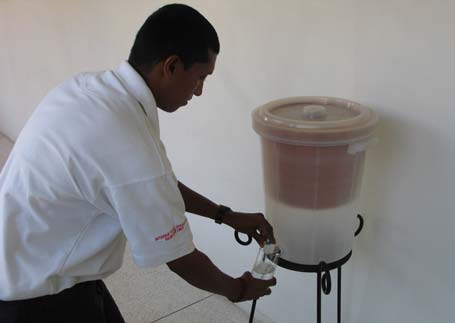
The CWF is a household unit of measurement for filtering, treating and storing potable water. Information technology consists of a porous clay "pot" suspended in a xx litre plastic receptacle with a tap located shut to the bottom, through which the clean water is drawn. Its functioning is straightforward: The plastic lid is removed and the clay pot is filled with water of uncertain quality. This gravity fed h2o passes slowly through the pores in the sides and bottom of the pot and is collected in the plastic receptacle.
During the process, the CWF removes sediment and treats contaminated water to attain quality standards set past the World Health System (WHO). Additionally, as a result of treating the pots with colloidal argent, a 2nd level of protection is provided to kill any leaner that may have passed through its microscopic pores.
Another important quality of the CWF is that it offers secure storage of the treated water which is easily accessible to household members. In Sri Lanka the receptacle is made of food grade plastic and a loftier quality tap is supplied for piece of cake assembly. Other countries have tried terra cotta and stainless steel receptacles. Still plastic is highly adequate as it is translucent, hands cleaned and light weight. Water quality analyses indicate that the filter eliminates approximately
98.00 percent of harmful bacteria and parasites. At an average of two litres per 60 minutes the CWF has the capacity to provide over 40 litres of water per day, enough to meet the drinking h2o needs of most families.
When did the clay filter originate?
Water filtration for habitation use with porous clay and sandstone receptacles dates back hundreds of years in both Central America and Asia. Below is a photo of a i,200 year old porous sandstone filter on display at the Sri Lanka National Museum.

The CWF technology utilised in Sri Lanka was adult in the early eighties in Guatemala and subsequently commercialised by the USA based Potters for Peace Organization (PfP), which saw it as a good response to the clean water needs of persons afflicted past Hurricane Mitchell. Over the years, several African and Asian countries have adopted the technology and accept been marketing them with high levels of community acceptance. PfP reports that up to xx countries are currently producing CWFs.
The CWF has been recognised internationally. In 2003 the Cambodian Red Cross clay water filter project won a World Bank Development Marketplace award. More recently, in early 2008 IDE was awarded the World Banking concern's East asia Projection Innovation Prize for its contribution to sustainable solutions for rural drinking h2o treatment.
What are the CWF components?
- Filter elements or pots are made in Sri Lanka under contract in factories situated in Matara and Kelaniya. Meticulous efforts take been invested in the production systems to ensure consistent product quality from both factories.
- Water receptacle (or buckets) with chapeau. These are made by a Kurunegala based producer. The translucent blue color differentiates CWFs sold on the commercial market from the white ones previously distributed gratis of accuse. Each bucket is branded with the SLRCS logo.
- A spigot with washers is supplied and instructions are given to ensure its leak-proof assembly to the bucket.
- Cleaning brush: A cleaning brush is provided with the dirt water filter kit then that families tin regularly clean them.
- Usage instructions brochure: These instructions help to educate new users on cleaning and maintenance.
How the CWFs are made in Sri Lanka
The clay pot production equipment consist of hammer mills, grinders, horizontal mixers, hydraulic presses and other tools that include moulds, sifters and weigh scales. Get-go, the rice husks are ground and fabricated gear up for mixing. 2d, the husks are mixed with dry clay and h2o until a homogenous clay sludge is ready. This dirt mixture is so shaped into blocks and taken to the press area where hydraulic presses are used to produce the bones pot shape.
At this stage the filter element looks much like an oversized establish pot. However, it is much more than than that as its rich husk content makes it ideal for filtering contaminated h2o. These "light-green" pots demand to be air-stale for 8 -12 days depending on the ambient temperature and humidity.
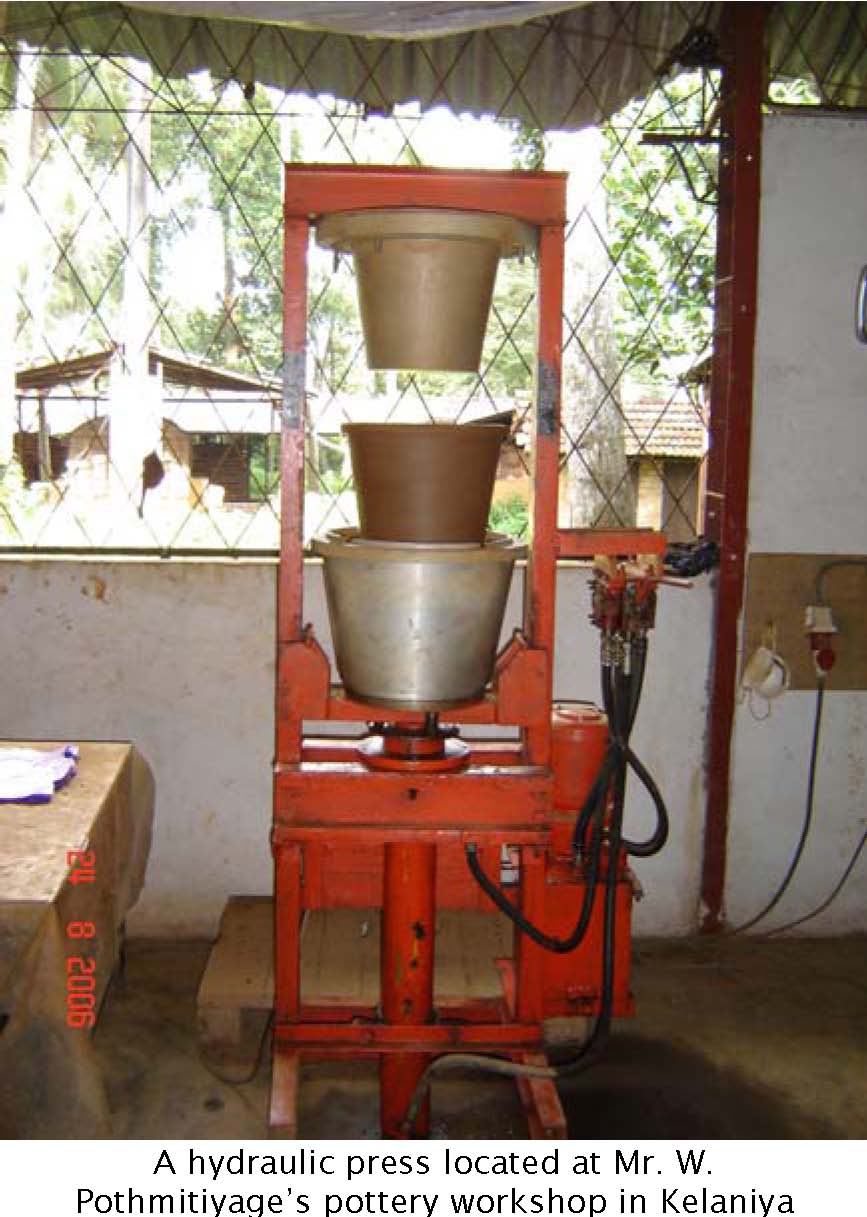
The side by side step in the process is kiln firing. Based on lessons learned from 3 Cambodian CWF producers, several minor kilns were built to ensure the precise control of firing temperatures. The pots are manually loaded and the wood-fuelled kilns are brought to a maximum temperature of 830 °C. During firing, the rice husk particles are completely burnt off, thus creating miniscule pores in the body of the pots. Digital pyrometers and pyrometric cones are used to ensure the correct temperatures and to make any necessary adjustments to the firing procedure. This key stage in the manufacturing procedure determines the efficacy of the filter elements. The increased porosity of the clay resulting from the burnt off material determines the water menstruum charge per unit and the effectiveness of leaner removal.
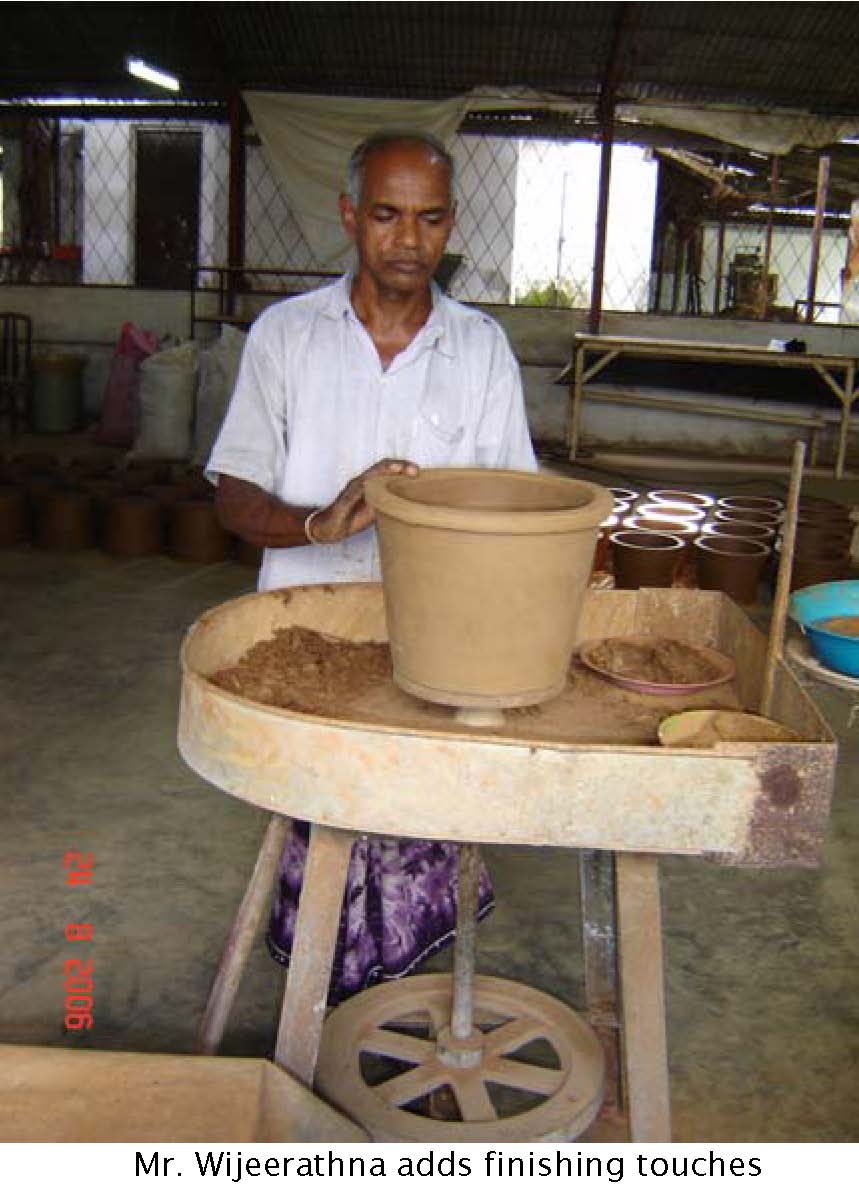
After a boring cooling process of 10-12 hours, the filters are immersed in a depression concentration of colloidal silver solution. This is an anti-bacterial amanuensis that was used extensively in medical practice prior to the development of antibiotics in the 1940s and 50s. The amount of silverish leached from the CWF to the filtered water is negligible (far below WHO guidelines for argent concentration in drinking water) and therefore has no issue on users' wellness. Colloidal silver provides a second level of protection.
Quality balls is emphasized throughout the manufacturing and sales procedure. These procedures range from the selection of clay and rice husks to flow charge per unit testing, too as the breaking and inspection of selected pots to assure complete kiln firing. Detailed factory records of the quality assurance tests are kept together with the serial number of each filter, its production and firing dates and the precise filtration rates.
Why is the CWF attractive to rural Sri Lankans?
The CWF'south advantages include its effectiveness, simplicity, portability and affordability. It is economical and requires no recurrent costs by the user. A CWF can filter from 1 – three litres of water per hour, enough to meet the drinking water needs of nigh families. Made by and large with indigenous materials by local potteries the CWF is more than environmentally friendly and affordable than most other household condom h2o methods as they are locally produced.
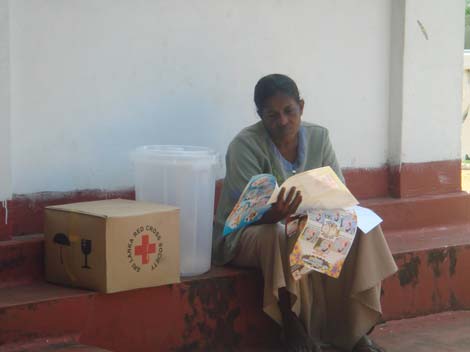
A Casher from Galle studies the Hygiene Promotion literature
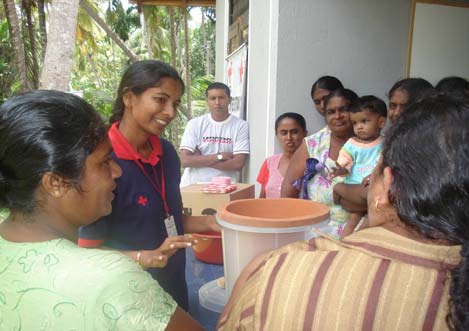
The CWF Projection offers extensive consumer support. Afterward the distribution and hygiene promotion events, project staff visit households twice. On the first visit, approximately one week after distribution, staff observe and give advice on how the CWFs take been assembled and located in the houses. During the 2d visit, approximately four weeks later, project staff carry out a presence/ absenteeism examination utilising a UNICEF approved bottled hydrogen sulphide kit. The samples of test water are kept for 24 hours. The presence of bacteria will cause the sample water to plough black, while make clean and therefore prophylactic water will remain colourless.
Convenient maintenance of the CWF includes monthly scrubbing of the filter "pot" using a soft brush or cloth to clear clogged pores and washing the plastic receptacle with soapy h2o to forbid bacterial growth. While CWFs are lightweight and portable, care must be taken during transport and treatment to avert breakage. The CWFs have an boilerplate two-twelvemonth lifespan.
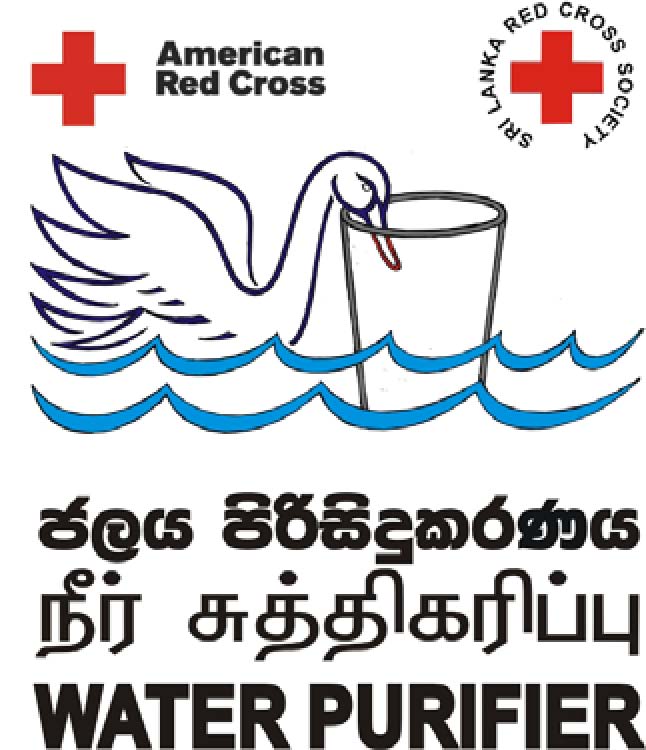
IFRC/American Red Cross
How To Make A Clay Water Filter,
Source: http://en.howtopedia.org/wiki/How_to_Make_the_Sri_Lankan_Clay_Water_Filter
Posted by: parkerowle1997.blogspot.com


0 Response to "How To Make A Clay Water Filter"
Post a Comment